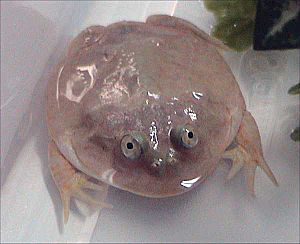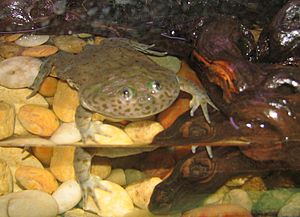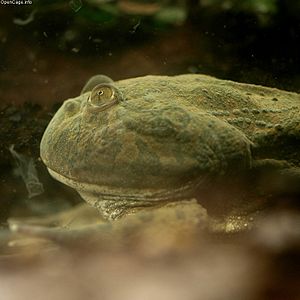Lepidobatrachus laevis facts for kids
Quick facts for kids Lepidobatrachus laevis |
|
|---|---|
 |
|
| Lepidobatrachus laevis in shallow water | |
| Conservation status | |
| Scientific classification |
Lepidobatrachus laevis, often called Budgett's frog, is a special type of frog. It belongs to the Ceratophryidae family. This frog was first found by John Samuel Budgett.
Many people enjoy keeping Budgett's frogs as pets. They have some funny nicknames too! You might hear them called "hippo frog" or even "Freddy Krueger frog." In some places, they are known as "escuerzo de agua."
Contents
What Does Budgett's Frog Look Like?
These frogs are quite popular because they look so funny and flat! They also seem to be very smart. Female frogs can grow up to 100 millimetres (3.9 in) long. Male frogs are usually about half that size.
Budgett's frogs have a very large head. It makes up about one-third of their whole body! They also have a really big mouth. Inside their mouth, they have a row of teeth on top. They also have two "fangs" on their lower jaw.
Their legs are very short and stubby. Their front feet do not have webs between the toes. Budgett's frogs are usually dark olive green. They have darker spots that are outlined in orange. Male frogs have a dark blue throat.
How Budgett's Frogs Live and Eat
This wide-mouthed frog is very good at living in its environment. This is especially true during the cold winter months. When it gets cold, the frog stays inactive underground. It forms a special cocoon around itself. This cocoon is made of its own shed skin. It helps the frog stay safe and keeps it from losing water. The frog stays in its cocoon until the weather gets warmer.
Budgett's frogs are usually quite aggressive. If they feel threatened, they will puff themselves up. This makes them look much bigger. If that doesn't scare away an intruder, they will make a loud, high-pitched screech. They might also bite or try to corner whatever is bothering them.
These frogs are nocturnal, meaning they hunt at night. They wait for their prey while submerged in water. Only their nostrils stick out. When an animal passes by, they lunge forward. They swallow their prey whole! They eat other frogs, insects, and snails. Sometimes, they even eat other Budgett's frogs.
Reproduction and Life Cycle
Budgett's frogs can lay many eggs at once. A female frog can produce up to 1,400 eggs in one mating! The male and female frogs will mate and lay their eggs in temporary pools of water.
The baby frogs, called embryos, grow very quickly. They develop in just about two weeks. This fast growth helps them turn into young frogs before the breeding pool dries up. When they hatch, the tadpoles are carnivores. This means they eat meat. They are also cannibalistic, so they might eat other tadpoles. Their jaws are almost like an adult frog's jaws right away. They become ready to have their own babies in about one year.
Where Budgett's Frogs Live and Their Safety
You can often find Budgett's frogs in Paraguay and Bolivia. They are seen less often in Argentina. Their natural habitats are the dry and wet areas of the Gran Chaco. They often lay their eggs in shallow, temporary pools or even in man-made ponds.
In some places, their homes are being lost. However, there are still many Budgett's frogs in total. Because there are so many of them and they live in a wide area, they are listed as "Least Concern." This means they are not currently in danger of disappearing.
Keeping Budgett's Frogs as Pets
Many people keep Budgett's frogs as pets. They are good for people who have some experience with frogs. A tank that is ten to twenty gallons is usually a good size. It's best not to use aquarium gravel in their tank. Frogs can accidentally swallow it, which can cause problems. River stones are a much safer choice.
You should also make sure there are rocks sloped in the tank. This allows the frog to easily get out of the water. These frogs usually don't need special heating. A comfortable room temperature of about 72 °F (22 °C) is fine for them.
It's important to keep Budgett's frogs alone. If you want to have more than one, make sure they are all the same size. This is because they will try to eat anything smaller than themselves!
See also
 In Spanish: Escuerzo de agua para niños
In Spanish: Escuerzo de agua para niños




